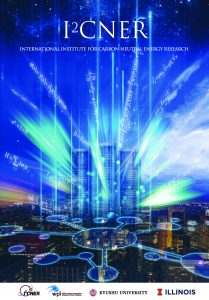Overview
The Institute is organized in thematic research clusters (divisions) which address specific research objectives. Each research division is led by a designated WPI Principal Investigator (Lead PI) of the Institute. Typically, there are several research groups within each division which focus on individual aspects of the primary division objectives. The divisions are:
- Molecular Photoconversion Devices
- Hydrogen Materials Compatibility
- Electrochemical Energy Conversion
- Thermal Science and Engineering
- Catalytic Materials Transformations
- CO2 Capture and Utilization
- CO2 Storage
- Energy Analysis
Not only are I2CNER’s researchers tasked with crossing the boundaries of various scientific disciplines, but they also must work hard to bridge the Pacific Ocean. The I2CNER project is highly unique, in that it has its main facility at Kyushu University (KU) in Japan and a Satellite facility at the University of Illinois at Urbana-Champaign (UIUC) in the United States. The research projects at UIUC are complementary to and integrated with those at KU. In addition, the Satellite Institute is a hub for identifying and engaging state of the art research programs and faculty at universities and other research institutions in the U.S. and internationally with which I2CNER can collaborate. These collaborations with first class international research centers, universities, and national laboratories help I2CNER to ensure that its mission has maximum impact in Japan and throughout the world. In order to sustain its fruitful international relationships, the I2CNER Administration encourages the Institute’s researchers to engage in exchange visits with all its international partners, especially the Satellite Institute. The symbiotic relationship between KU and UIUC is exemplary of I2CNER’s vision for the international collaborations necessary to achieve breakthroughs in fundamental science.
To download a copy of the I2CNER Brochure, click here.



